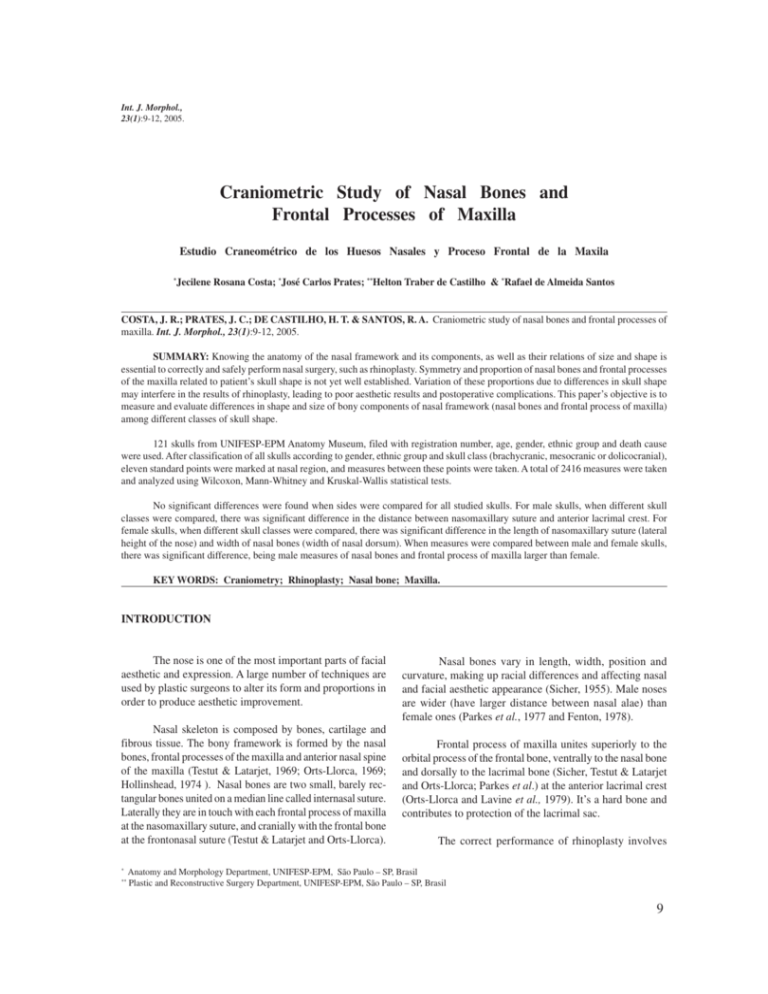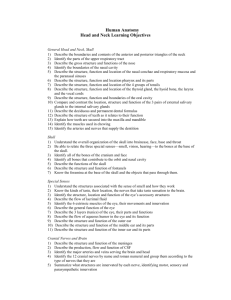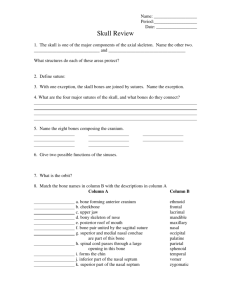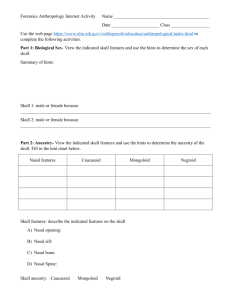Craniometric Study of Nasal Bones and Frontal Processes
advertisement

Int. J. Morphol., 23(1):9-12, 2005. Craniometric Study of Nasal Bones and Frontal Processes of Maxilla Estudio Craneométrico de los Huesos Nasales y Proceso Frontal de la Maxila * Jecilene Rosana Costa; *José Carlos Prates; **Helton Traber de Castilho & *Rafael de Almeida Santos COSTA, J. R.; PRATES, J. C.; DE CASTILHO, H. T. & SANTOS, R. A. Craniometric study of nasal bones and frontal processes of maxilla. Int. J. Morphol., 23(1):9-12, 2005. SUMMARY: Knowing the anatomy of the nasal framework and its components, as well as their relations of size and shape is essential to correctly and safely perform nasal surgery, such as rhinoplasty. Symmetry and proportion of nasal bones and frontal processes of the maxilla related to patient’s skull shape is not yet well established. Variation of these proportions due to differences in skull shape may interfere in the results of rhinoplasty, leading to poor aesthetic results and postoperative complications. This paper’s objective is to measure and evaluate differences in shape and size of bony components of nasal framework (nasal bones and frontal process of maxilla) among different classes of skull shape. 121 skulls from UNIFESP-EPM Anatomy Museum, filed with registration number, age, gender, ethnic group and death cause were used. After classification of all skulls according to gender, ethnic group and skull class (brachycranic, mesocranic or dolicocranial), eleven standard points were marked at nasal region, and measures between these points were taken. A total of 2416 measures were taken and analyzed using Wilcoxon, Mann-Whitney and Kruskal-Wallis statistical tests. No significant differences were found when sides were compared for all studied skulls. For male skulls, when different skull classes were compared, there was significant difference in the distance between nasomaxillary suture and anterior lacrimal crest. For female skulls, when different skull classes were compared, there was significant difference in the length of nasomaxillary suture (lateral height of the nose) and width of nasal bones (width of nasal dorsum). When measures were compared between male and female skulls, there was significant difference, being male measures of nasal bones and frontal process of maxilla larger than female. KEY WORDS: Craniometry; Rhinoplasty; Nasal bone; Maxilla. INTRODUCTION The nose is one of the most important parts of facial aesthetic and expression. A large number of techniques are used by plastic surgeons to alter its form and proportions in order to produce aesthetic improvement. Nasal skeleton is composed by bones, cartilage and fibrous tissue. The bony framework is formed by the nasal bones, frontal processes of the maxilla and anterior nasal spine of the maxilla (Testut & Latarjet, 1969; Orts-Llorca, 1969; Hollinshead, 1974 ). Nasal bones are two small, barely rectangular bones united on a median line called internasal suture. Laterally they are in touch with each frontal process of maxilla at the nasomaxillary suture, and cranially with the frontal bone at the frontonasal suture (Testut & Latarjet and Orts-Llorca). * ** Nasal bones vary in length, width, position and curvature, making up racial differences and affecting nasal and facial aesthetic appearance (Sicher, 1955). Male noses are wider (have larger distance between nasal alae) than female ones (Parkes et al., 1977 and Fenton, 1978). Frontal process of maxilla unites superiorly to the orbital process of the frontal bone, ventrally to the nasal bone and dorsally to the lacrimal bone (Sicher, Testut & Latarjet and Orts-Llorca; Parkes et al.) at the anterior lacrimal crest (Orts-Llorca and Lavine et al., 1979). It’s a hard bone and contributes to protection of the lacrimal sac. The correct performance of rhinoplasty involves Anatomy and Morphology Department, UNIFESP-EPM, São Paulo – SP, Brasil Plastic and Reconstructive Surgery Department, UNIFESP-EPM, São Paulo – SP, Brasil 9 COSTA, J. R.; PRATES, J. C.; DE CASTILHO, H. T. & SANTOS, R. A. knowledge of anatomy and physiology of face and skull, as well as its embryology, bone growth pattern and deviations from normality. Although aesthetic aspects are the most important for nearly all patients, the surgeon should set priority to function preservation in all cases (Thomas et al., 1987 and Castro, 1997). To achieve optimal aesthetical outcomes, some noses require lateral osteotomy, depending on factors like thickness of frontal process of the maxilla, relation between nasal dorsum and interalar widths, sexual and ethnic aspects (Parkes et al; Osguthorpe & Calcaterra, 1979; Thomas et al.; Daniel & Letourneau, 1988 and Sullivan et al., 1996 Rhinoplasties involving lateral osteotomy may cause problems like poor aesthetical outcomes, airway obstruction, lacrimal sac injuries and temporary lacrimal duct obstruction. Minimizing these complications involves detailed anatomical knowledge of nasal bony and cartilaginous structure, as well as of frontal process of maxilla, where osteotomy is performed (Parkes et al.). Different patients have different skull measures and proportions, and the knowledge of such variations may help in planning and executing osteotomies in rhinoplasty more safely. Literature is not clear about variations in symmetry of nasal bones. Dimensional relations of facial bones involved in osteotomy for female and male skulls in different skull classes are not well established. This paper’s objective is to evaluate symmetry of nasal bones, and to compare facial measures related to nasal bones, frontal processes of maxilla and anterior lacrimal crests, according to sex and skull class. MATERIAL AND METHOD After appreciation and approval by the Ethics in Research Committee at UNIFESP-EPM, 121 skulls from UNIFESP-EPM Anatomy Museum, filed with registration number, age, sex, ethnic group and death cause were used. Horizontal Cranic Index (HCI) was first calculated, taking measures with a round pointed compass. HCI shows the relation between maximum transverse and antero-posterior skull diameters. It’s obtained using the formula: HCI = maximum transverse diameter x 100 maximum antero-posterior diameter 10 Maximum antero-posterior diameter is measured from the glabella to the most prominent part of the occipital bone. Maximum transverse diameter is measured from one eurion to the opposite one. Skulls were then classified according to Garson1: lower than 64,9 – Ultradolicocranial; 65,0 to 69,9 – Hyperdolicocranial; 70,0 to 74,9 – Dolicocranial; 75,0 to 79,9 – Mesocranic; 80,0 to 84,9 – Brachycranic; 85,0 to 89,9 – Hyperbrachycranic; higher than 90,0 – Ultrabrachycranic. Ultradolicocranials and Hyperdolicocranials were grouped with Dolicocranials, and Hyperbrachycranic and Ultrabrachycranic were grouped with Brachycranics. After HCI classification, skulls were also classified according to gender (male and female) and ethnic group (white and non-white). Each skull was then marked at standardized points “A” to “K” (Figure 1), and distances A-B, A-C, A-D, B-E, B-F, C-E, D-F, G-H, G-I, H-I, G-J, G-K, J-K and K-I were measured. All measures were performed by the same researcher, in a standardized way, totalizing 2146 measures, grouped according to gender and skull class. (Fig. 1). Differences among measures taken on each side, for each gender and skull class were analyzed using Wilcoxon non-parametric test. Differences between single measures among skull classes for each gender were assessed using Kruskal-Wallis non-parametric test, complemented if necessary by Dun multiple comparison test. When Wilcoxon test showed no significant differences between sides, data was grouped. Differences between male and female skulls were evaluated using Mann-Whitney non-parametric test. The rejection level for null hypothesis was fixed at 0,05 or 5% (a ≤ 0,05). RESULTS From 71 male skulls, 28 were brachycranics, 23 mesocranics and 20 dolicocranials. From 50 female skulls, 18 were brachycranics, 23 mesocranics and nine dolicocranials. For male skulls, there was significant difference only when measures H-I and J-K were compared between sides. For female skulls, there was significant differences when variables C-E x D-F and G-H x G-J were compared in different skull classes. Craniometric study of nasal bones and frontal processes of maxilla. Int. J. Morphol., 23(1):9-12, 2005. There were no significant differences amongst sides or skull classes for the variables A-C x A-D, B-E x B-F, G-I x G-K and H-I x J-K. Variables C-E x D-F and G-H x G-J presented significant differences when skull classes were compared, but when sides were compared, no differences were found. DISCUSSION All studied skulls were well preserved, allowing correct measuring of HCI and distances among standard points. Only adult skulls were used, in order to minimize metric influence produced by changes during growth period. Mean distances between nasomaxillary suture and anterior lacrimal crest (H-I and J-K) were 7,16 mm for male and 6,47 for female skulls. Measuring HCI allowed classification of skulls in brachycranics, mesocranics and dolicocranials, making it possible to compare differences in proportions amongst skull classes for male and female. Analysis of measures A-C, B-E, C-E, A-B, AD, B-F, D-F and A-B among all skulls showed that nasal bones are symmetric, disaccording to some authors12,15, and that their shape is four-sided but not rectangular, according to part of the consulted literature (Sicher and Rouvière & Delmas, 1985). Male skulls showed significant difference in measures only when compared right and left sides for H-I and J-K distances, suggesting that safety of fractures in rhinoplasty is not influenced by patient's skull class. Female skulls showed significant differences among skull classes when measures C-E, D-F, G-H and G-J were compared. C-E and D-F measures represent length of nasomaxillary suture; G-H and G-J measures represent width of nasal bones. These findings suggest that, for female patients, safety of fractures in rhinoplasty may be influenced by skull class. Fig. 1. Standardized points on nasal bones and frontal processes of maxilla A: Nasion, union point between frontal and nasal bones; B: Rhinion, most caudal point of internasal suture; C: Union point between right frontal, nasal and maxillary bones; D: Union point between left frontal, nasal and maxillary bones; E: Most caudal point of right nasomaxillary suture; F: Most caudal point of left nasomaxillary suture; G: Midpoint of internasal suture; H: Point marked at left nasomaxillary suture where it crosses an imaginary horizontal line passing by point “G”; I: Point marked at left anterior lacrimal crest where it crosses an imaginary horizontal line passing by points “G” and “H”; J: Point marked at right nasomaxillary suture where it crosses an imaginary horizontal line passing by point “G”; K: Point marked at right anterior lacrimal crest where it crosses an imaginary horizontal line passing by points “G” and “J”; Comparison of measures C-E and D-F between male and female skulls showed significant differences in all skull classes, with male measures larger than female. This finding is according to the consulted literature (Martin & Saller, 1962; Parkes; Fenton and Sullivan). ACKNOWLEDGMENTS The authors would like to express their gratitude for Professors Ricardo Luiz Smith, M.D., P.H.D. and Luís Garcia Alonso, M.D., P.H.D., from Anatomy and Morphology Department at UNIFESPEPM, for their counseling and help during this study. 11 COSTA, J. R.; PRATES, J. C.; DE CASTILHO, H. T.; SANTOS, R. A. COSTA, J. R.; PRATES, J. C.; DE CASTILHO, H. T. & SANTOS, R. A. Estudio craniométrico de los huesos nasales y proceso frontal de la maxila. Int. J. Morphol., 23(1):9-12, 2005. RESUMEN: Conociendo correctamente la anatomía del marco nasal y sus componentes, como también sus relaciones de tamaño y forma, se pueden realizar cirugías nasales, como la rinoplastía. No está aún bien establecida la simetría y proporción de los huesos nasales y procesos frontales de la maxila con la forma de los cráneos de pacientes. Variaciones de estas proporciones, debido a diferencias en la forma de los cráneos, puede interferir en los resultados de la rinoplastía, obteniéndose escasos resultados estéticos y complicaciones postoperatorias. El objetivo de este artículo fue medir y evaluar diferencias en la forma y tamaño de los componentes óseos del marco nasal (huesos nasales y proceso frontal de la maxila) entre diferentes formas de cráneos. Fueron estudiados 121 cráneos de la colección del Museo de Anatomía de la Universidade Federal de São Paulo - EPM, Brasil. De ellos se registró el número de clasificación, la edad, género, grupo étnico y causa de muerte. Después de la clasificación de los cráneos en braquicráneo, mesocráneo y dolicocráneo, fueron marcados 11 puntos en la región nasal, siendo tomadas las medidas de estos puntos. Un total de 2416 medidas fueron recolectadas y analizadas usando los tests estadísticos de Wilcoxon, Mann-Whitney y Kruskal-Wallis. No fueron encontradas diferencias significativas cuando se compararon ambos lados en los cráneos. En cambio, hubo diferencias estadísticamente significativas cuando se compararon cráneos de hombres de diferentes clasificaciones antropométricas, en la distancia entre la sutura nasomaxilar y la cresta lacrimal anterior. En el caso de cráneos de mujeres, cuando fueron comparados por clasificación, hubo diferencias estadísticamente significativas en la longitud y la sutura nasomaxilar (altura de la nariz) y ancho de los huesos nasales (ancho del dorso nasal). Cuando las medidas fueron comparadas entre cráneos de hombres y mujeres, hubo diferencias estadísticamente significativas, siendo en los hombres los huesos nasales y los procesos frontales de la maxila, más grandes que en las mujeres. KEY WORDS: Craniometry; Rhinoplasty; Nasal bone; Maxilla. REFERENCES Castro O. Princípios e prioridades em cirurgia plástica. São Paulo, Fundo Editorial BYK, 1997. Daniel, R. K. & Letourneau, A. Rhinoplasty: nasal anatomy. Annals of Plastic Surgery, 20(1):5-13, 1988. Fenton, R. S. Surgery of the nasal dorsum. J. Otolaryngology, 7 (1):24-8, 1978. Hollinshead, W. H. Textbook of anatomy. 3. ed. New York, Harper & How, 1974. Lavine, D. M.; Lehman, J. A. & Jackson, T. Is the lacrimal apparatus injured following cosmetic rhinoplasty? Arch. Otolaryngol., 105 (12):719- 20, 1979. Martin, R. & Saller, K. Lehrbuch der anthropologie. Stuttgart, Gustav Fischer Verlag. Band III, 1962. Ortis-Llorca, F. Anatomía Humana. 4. ed. Barcelona, Editorial Científico- Médica, 1969. V. 1. Osguthorpe, J. D. & Calcaterra, T. C. Nasolacrimal obstruction after maxillary sinus and rhinoplastic surgery. Arch. Otolaryngol., 105 (5):264-6, 1979. Parkes, M. L.; Kamer, F. & Morgan, W. R. Double lateral osteotomy in rhinoplasty. Arch Otolaryngol., 103 (6):344-8, 1977. Rouvière, H. & Delmas, A. 2. ed. Anatomie Humaine descriptive, topographique et fonctionnelle. Paris, Masson, 1985. V. 3. 12 Sicher, H. Anatomia oral. 2. ed. Rio de Janeiro, Atheneu, 1955. Sullivan, P. K.; Varma, M. & Rozzelle, A. A. Optimizing bonegraft nasal reconstruction: a study of nasal bone shape and thickness. Plastic and Resconstructive Surgery, 97 (2): 32735, 1996. Testut, L. & Latarjet, A. Tratado de Anatomía Humana. 9. ed. Barcelona, Salvat, 1969. V. 1. Thomas, J. R.; Griner, N. R. & Remmler, D. J. Steps for a safe method of osteotomies in rhinoplasty. Laryngoscope, 97 (6):746-7, 1987. Correspondence to: Dra. Jecilene Rosana Costa Rua José Yazigi, 108, Morumbi, CEP: 05658-020 São Paulo – SP BRASIL Phone/Fax: (5511)3742-6938 (Phone)/ (5511)3742-0110 (Fax) e-mail: jecilenefisio@hotmail.com Received : 07-10-2004 Accepted: 11-01-2005








